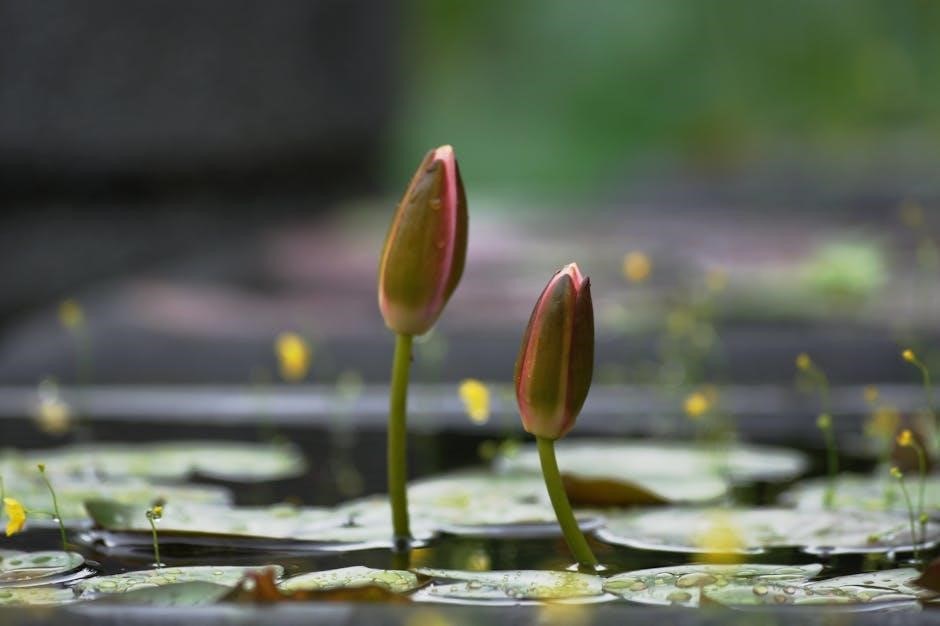
Welcome to the Pond Armor instructions guide. This comprehensive resource covers everything needed to apply Pond Armor effectively and safely for various surfaces, ensuring optimal results.
1.1 Overview of Pond Armor
Pond Armor is a non-toxic, eco-friendly epoxy coating designed for waterproofing and protecting various surfaces, including concrete, wood, and metal. It is ideal for ponds, water tanks, and other containment systems. The coating is durable, UV-resistant, and safe for aquatic life, making it a popular choice for outdoor and underwater applications. Pond Armor offers excellent adhesion and flexibility, ensuring long-lasting protection against leaks and environmental stress. Its user-friendly application process and versatile compatibility with different materials make it a reliable solution for both DIY projects and professional installations. This coating is specifically formulated to withstand harsh conditions and provide a watertight seal.
1.2 Importance of Following Instructions
Adhering to Pond Armor instructions is crucial for achieving a durable, watertight seal. Proper preparation, mixing, and application ensure optimal performance and longevity. Deviating from guidelines can lead to peeling, cracking, or incomplete curing. Surface preparation, such as etching and cleaning, is essential for strong adhesion. Mixing procedures must be followed precisely to avoid premature hardening. Applying thin, even coats and allowing proper curing times ensures a professional finish. Following instructions guarantees safety, effectiveness, and long-term protection for your pond or water containment system, making it vital for both DIY enthusiasts and professionals.

Surface Preparation
Proper surface preparation is essential for a successful Pond Armor application. This step ensures the surface is clean, free of contaminants, and has the necessary texture for optimal adhesion.
2.1 Etching Concrete and Other Surfaces
Etching concrete and other surfaces is a critical step in preparing for Pond Armor application. Use an eco-friendly acid solution like Surface Prep to remove residual calcium sulphate and contaminants. For concrete, spray the solution, wait a few minutes, then rinse thoroughly. The surface should feel like 60-grit sandpaper after proper etching. For stone, brick, or metal surfaces, grinding or sandblasting may be necessary to create texture and ensure proper adhesion. Always follow safety guidelines and rinse surfaces completely before proceeding to the next step.
2.2 Cleaning and Removing Contaminants
Cleaning and removing contaminants is essential for proper adhesion of Pond Armor. Use a strong concrete degreaser to eliminate oils, greases, or sealers from the surface. For silicone-based contaminants, apply a degreaser and rinse thoroughly. Ensure the surface is free of dirt, dust, and other substances that could interfere with the coating. After cleaning, rinse the surface with clean water to remove any residue. Allow it to dry completely before proceeding. A clean surface ensures optimal bonding and long-lasting durability of the Pond Armor coating. Always follow safety guidelines when handling cleaning agents.
2.3 Creating Surface Tooth
Creating surface tooth is crucial for proper adhesion of Pond Armor. For concrete, use a grinder with a flexible abrasive disk to achieve a texture similar to 60-grit sandpaper. Wood surfaces should be sanded to feel like 60-grit sandpaper, with hand sanding recommended for better texture. Stone or rock surfaces may require grinding or sandblasting to create adequate surface tension. Metal surfaces, such as steel or aluminum, should be ground to add tooth and ensure a clean, rust-free surface. Proper surface preparation ensures the coating adheres effectively, enhancing durability and performance. Always follow specific guidelines for your material type.
Mixing Pond Armor
Mixing Pond Armor requires careful preparation. Start with small batches to gauge workability. Use a stick for small mixes or a drill mixer for larger quantities. Always scrape the sides and bottom of the mixing container to ensure complete incorporation of materials, as incomplete mixing can prevent proper curing. Pour the mixed material into a paint pan or apply directly to avoid shortening the pot life. Follow temperature and humidity guidelines for optimal results.
3.1 Preparing to Mix
Before mixing Pond Armor, ensure all materials and tools are ready. Start with the smallest batch size to assess workability. Temperature, humidity, and surface type influence mixing. Gather a mixing stick or drill mixer for larger quantities. Always scrape the container’s sides and bottom to ensure thorough incorporation. Avoid over-mixing, as this can shorten the material’s pot life. Prepare a clean, level workspace and wear protective gear; Follow the kit instructions for precise measurements. Mix only what can be applied within 30 minutes to maintain optimal performance. Proper preparation ensures a smooth and effective application process.
3.2 Mixing Tools and Techniques
Use a mixing stick for small batches or a drill mixer on low speed for larger quantities. Always scrape the sides and bottom of the container to ensure even mixing. Fold the material thoroughly to avoid unmixed areas. For best results, mix in a well-ventilated area and wear protective gear. Over-mixing can reduce workability, so mix only until components are fully incorporated. Pour the mixed material into a paint pan or apply directly to the surface. Avoid leaving the mix in the original container to prevent premature curing. Proper mixing ensures a smooth, even application and optimal performance of Pond Armor.
3.3 Handling the Mixed Material
After mixing, work quickly to apply the material within the recommended working time, typically 30 minutes. Use gloves and protective gear to prevent skin contact. Avoid leaving the mixed material in the original container, as it can cure prematurely. Pour the mixture into a large paint pan or apply directly to the surface. Keep the area well-ventilated to prevent inhaling fumes. If the material begins to set, stop and mix a fresh batch. Environmental factors like temperature and humidity can affect pot life. Always refer to the FAQ section for additional handling tips and safety precautions during application.

Application Methods
Pond Armor can be applied using brushes, rollers, or specialized tools for joints and gaps, ensuring smooth, even coverage and optimal adhesion to various surfaces.
4.1 Using Brushes and Rollers
For smooth surfaces, use high-quality brushes or rollers to apply Pond Armor evenly. Brushes are ideal for detailed work, while rollers cover larger areas quickly. Ensure the surface is clean and properly prepared. Apply thin, uniform coats, allowing each to cure slightly before the next; Avoid over-application, as this can lead to uneven drying. Use gloves to prevent oil from your skin contaminating the surface. Rollers are especially effective for rough surfaces, but brushes are better for joints and edges. Always follow mixing instructions to maintain the right consistency for smooth application and proper adhesion.
4.2 Applying Thin Coats
Thin coats are essential for proper adhesion and curing. Apply the first coat evenly, ensuring full coverage without over-application. Allow it to cure slightly until tacky but not wet. Subsequent coats should be applied in the same manner, with minimal buildup to avoid cracking. Wood surfaces may require additional thin layers due to absorption. Always work in small sections to maintain control. This method ensures a durable, watertight finish. Proper thin coat application is critical for long-term performance and structural integrity.

4.3 Special Techniques for Joints and Gaps
For joints and gaps, use fiberglass mat or woven fiberglass for added strength. Apply a thin coat of Pond Armor, then press the material firmly into place. For gaps, use Crack RX caulk to fill them before coating. Once dry, sand lightly and apply the final coat. Aquarium-safe silicone can also be used over the coating for extra sealing. Ensure surfaces are clean and lightly sanded for proper adhesion. These techniques ensure long-lasting protection and prevent leaks in critical areas. Proper preparation and material selection are key to achieving a watertight seal.
Specific Surface Instructions
This section provides tailored guidance for applying Pond Armor to various surfaces, including concrete, wood, metal, and plastics, ensuring proper preparation and adherence.
5.1 Concrete Surfaces
For concrete surfaces, proper preparation is crucial. Begin by etching the surface to remove calcium sulphate, ensuring a clean, porous base for the coating. Use Pond Armor Surface Prep, a user-friendly acid solution, and rinse thoroughly. The surface should feel like 60-grit sandpaper after etching. For uneven areas, grind with a flexible disk or apply a thin render with a bonding agent. Fill holes or pits with Pond Shield primer before coating. Ensure the surface is free of contaminants like sealers or grease, using a degreaser if necessary. A well-prepared concrete surface ensures optimal adhesion and durability of the Pond Armor coating.
5.2 Wood Surfaces
When applying Pond Armor to wood surfaces, start by sanding the wood to achieve a texture similar to 60-grit sandpaper. Close-grain wood is ideal as it swells less when coated. Sanding can be done with a power sander, but hand-sanding is recommended to create grooves for better adhesion. Apply the first coat and allow it to cure for a few hours until tacky. Subsequent coats can be applied after 30-60 minutes. Ensure the final thickness is at least 10 mils. Proper ribbing and support systems are essential to maintain structural integrity and water tightness, especially due to wood’s natural flexibility.
5.3 Metal Surfaces
For metal surfaces, begin by grinding with a flexible disk to create a surface texture similar to 60-grit sandpaper. Ensure the surface is free of rust and corrosion. After cleaning, apply a self-etching primer before coating. For galvanized steel, if any galvanization remains post-grinding, etch the surface with white vinegar. This ensures proper adhesion and prevents coating failure. Always sand aluminum and stainless steel to remove oxidation. These steps guarantee a strong bond and long-lasting durability of the Pond Armor coating on metal surfaces.
5.4 Plastic and Other Materials
For plastics like ABS and PVC, sand with 60-grit sandpaper and wipe clean. Apply PVC primer minutes before coating. Other plastics may require similar prep; Polyethylene and polypropylene are challenging as they repel coatings; consult manufacturers for specifics. Fiberglass should be sanded and cleaned with wax and grease remover for proper adhesion. Ensure all surfaces feel like 60-grit sandpaper before applying Pond Armor. This ensures a strong bond and long-lasting protection for plastic and other unique materials.